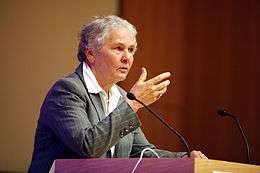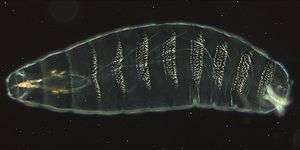Christiane Nüsslein-Volhard
Christiane (Janni) Nüsslein-Volhard (born 20 October 1942) is a German developmental biologist and 1995 Nobel Prize-winner.
Christiane Nüsslein-Volhard | |
|---|---|
 | |
| Born | 20 October 1942 Magdeburg, Germany |
| Nationality | German |
| Alma mater | University of Tübingen (PhD) |
| Awards | |
| Scientific career | |
| Fields | |
| Institutions | |
| Thesis | Zur spezifischen Protein-Nukleinsäure-Wechselwirkung : die Bindung von RNS-Polymerase aus Escherichia coli an die Replikative-Form-DNS des Bakteriophagen fd und die Charakterisierung der Bindungsstellen (1974) |
| Doctoral advisor | Heinz Schaller |
| Website | www |


Nüsslein-Volhard earned her PhD in 1974 from the University of Tübingen, where she studied protein-DNA interaction. She won the Albert Lasker Award for Basic Medical Research in 1991 and the Nobel Prize in Physiology or Medicine in 1995, together with Eric Wieschaus and Edward B. Lewis, for their research on the genetic control of embryonic development.[2][3] She lives in Bebenhausen, Germany.[4]
Early life
Nüsslein-Volhard was born in Magdeburg on 20 October 1942. She has four siblings: three sisters and one brother. Her father was an architect, so she grew up exposed to art and thus was "trained in looking at things and recognizing things".[5][6]
Education
Nüsslein-Volhard was educated at the University of Tübingen where she earned a PhD in 1974 for research into Protein–DNA interactions and the binding of RNA polymerase in Escherichia coli.[7][8]
Research
The experiments that earned Nüsslein-Volhard and Wieschaus their Nobel prize aimed to identify genes involved in the development of Drosophila melanogaster (fruit fly) embryos. At this point (the late 1970s and early 1980s) little was known about the genetic and molecular mechanisms by which multicellular organisms develop from single cells to morphologically complex forms during embryogenesis.
Fruit flies have long been an important model organism in genetics due to their small size and quick generation time, which makes even large numbers of them relatively easy to maintain and observe in the laboratory.[9] Nüsslein-Volhard and Wieschaus identified genes involved in embryonic development by a series of genetic screens. They generated random mutations in fruit flies using EMS (ethyl methanesulfonate). Some of these mutations affected genes involved in the development of the embryo. Nüsslein-Volhard and Wieschaus took advantage of the segmented form of Drosophila larvae to address the logic of the genes controlling development. In normal unmutated Drosophila, each segment produces bristles called denticles in a band arranged on the side of the segment closer to the head (the anterior). The researchers looked at the pattern of segments and denticles in each mutant under the microscope, and were therefore able to work out that particular genes were involved in different processes during development based on their differing mutant phenotypes (such as fewer segments, gaps in the normal segment pattern, and alterations in the patterns of denticles on the segments).[10] Many of these genes were given descriptive names based on the appearance of the mutant larvae, such as hedgehog, gurken (German: "cucumbers"), and Krüppel ( "cripple"). Later, researchers identified exactly which gene had been affected by each mutation, thereby identifying a set of genes crucial for Drosophila embryogenesis. The subsequent study of these mutants and their interactions led to important new insights into early Drosophila development, especially the mechanisms that underlie the step-wise development of body segments.
These experiments are not only distinguished by their sheer scale (with the methods available at the time, they involved an enormous workload), but more importantly by their significance for organisms other than fruit flies. It was later found that many of the genes identified here had homologues in other species. In particular, the homeobox genes (coding for transcription factors critically involved in early body development) are found in all metazoans, and usually have similar roles in body segmentation.
These findings have also led to important realizations about evolution – for example, that protostomes and deuterostomes are likely to have had a relatively well-developed common ancestor with a much more complex body plan than had been conventionally thought.
Additionally, they greatly increased our understanding of the regulation of transcription, as well as cell fate during development.
Nüsslein-Volhard is associated with the discovery of Toll, which led to the identification of toll-like receptors.[11]
Later work
Since 1985 Christiane Nüsslein-Volhard has been Director of the Max Planck Institute for Developmental Biology in Tübingen and also leads its Genetics Department. In 1986, she received the Gottfried Wilhelm Leibniz Prize of the Deutsche Forschungsgemeinschaft, which is the highest honour awarded in German research. Since 2001 she has been member of the Nationaler Ethikrat (National Ethics Council of Germany) for the ethical assessment of new developments in the life sciences and their influence on the individual and society. Her primer for the lay-reader, Coming to Life: How Genes Drive Development, was published in April 2006.
In 2004 Nüsslein-Volhard started the Christiane Nüsslein-Volhard Foundation (Christiane Nüsslein-Volhard Stiftung).[3] It is meant to aid promising young female German scientists with children. The foundation's main focus is to facilitate childcare as a supplement to existing stipends and day care.
Awards and honors
- 1986: Gottfried Wilhelm Leibniz Prize of the German Research Foundation[12]
- 1986: Franz Vogt Award of the University of Giessen
- 1989: Founding member of the Academia Europaea[13]
- 1989: Corresponding member of the Heidelberg Academy of Sciences[14]
- 1990: Corresponding member of North Rhine-Westphalia Academy for Sciences and Arts
- 1990: Elected a Foreign Member of the Royal Society (ForMemRS),[15][16][17] London
- 1990: Member of the National Academy of Sciences, Washington[18]
- 1991: Member of the German Academy of Sciences Leopoldina[19]
- 1991: Albert Lasker Award for Basic Medical Research[20]
- 1991: Honorary doctorate from the University of Utrecht[21]
- 1991: Honorary doctorate from Princeton University[22]
- 1991: Keith R. Porter Lecture[23]
- 1992: Alfred P. Sloan, Jr. Prize[24]
- 1992: Louis-Jeantet Prize for Medicine[1]
- 1992: Louisa Gross Horwitz Prize from Columbia University[25]
- 1992: Otto Warburg Medal of the German Society for Biochemistry and Molecular Biology[26]
- 1993: Honorary doctorate from the University of Freiburg[27]
- 1993: Honorary doctorate from Harvard University[28]
- 1993: Sir Hans Krebs Medal from the Federation of European Biochemical Societies[29]
- 1993: Ernst Schering Prize[30]
- 1994: Merit Cross of the Federal Republic of Germany
- 1995: Nobel Prize in Physiology or Medicine[31]
- 1996: Order of Merit of Baden-Württemberg
- 1997: Pour le Mérite for Sciences and Arts[32]
- 2001–2006: Member of the National Ethics Council of the Federal Government
- 2005: Grand Merit Cross with Star and Sash of the Federal Republic of Germany (Großes Verdienstkreuz mit Stern und Schulterband)[33]
- 2007: German Founder Award of the Federation of German Foundations
- 2008: Mercator Professorship, University of Duisburg-Essen
- 2009: Austrian Decoration for Science and Art[34]
- 2011: Honorary doctorate from the University of St Andrews
- 2012: Honorary doctorate from the University of Bath[35]
- 2013: Chancellor of the order Pour le Mérite for Sciences and Arts[32]
- 2014: Bavarian Maximilian Order for Science and Art[36]
- Member of the French Academy of Sciences
- Member of the Scientific Committee of the Ingrid zu Solms Foundation
- Member of the European Molecular Biology Organization[37]
- The asteroid 15811 Nüsslein-Volhard is named in her honour[38]
Honorary degrees
Christiane Nüsslein-Volhard has been awarded honorary degrees by the following Universities: Yale, Harvard, Princeton, Rockefeller, Utrecht, University College London, Oxford (June 2005), Sheffield, St Andrews (June 2011), Freiburg, Munich and Bath (July 2012).[39][35]
See also
References
- "Professor Christiane NÜSSLEIN-VOLHARD | Jeantet". October 1, 2017.
- "Eric Wieschaus and Christiane Nüsslein-Volhard: "Collaborating to Find Developmental Genes"". ibiology.org.
- "CNV Stiftung - Startseite". www.cnv-stiftung.de.
- Müssigmann, Lena (19 October 2017). "Am Wochenende ist sie nicht mehr im Büro". Der Spiegel (in German). Hamburg. Retrieved 5 October 2018.
- An interview with Christiane Nüsslein-Volhard, 2017
- "A biography of Christiane Nüsslein-Volhard".
- Nüsslein-Volhard, Christiane (1974). Zur spezifischen Protein-Nukleinsäure-Wechselwirkung : die Bindung von RNS-Polymerase aus Escherichia coli an die Replikative-Form-DNS des Bakteriophagen fd und die Charakterisierung der Bindungsstellen (PhD thesis). University of Tübingen. OCLC 793770536.
- "Christiane Nüsslein-Volhard - Nobel Lecture: The Identification of Genes Controlling Development in Flies and Fishes". nobelprize.org.
- Arias AM (2008). "Drosophila melanogaster and the development of biology in the 20th century". Drosophila. Methods in Molecular Biology. 420. pp. 1–25. doi:10.1007/978-1-59745-583-1_1. ISBN 978-1-58829-817-1. PMID 18641938.
- Nüsslein-Volhard C, Wieschaus E (October 1980). "Mutations affecting segment number and polarity in Drosophila". Nature. 287 (5785): 795–801. Bibcode:1980Natur.287..795N. doi:10.1038/287795a0. PMID 6776413.
- Hansson, G. K.; Edfeldt, K. (June 2005). "Toll To Be Paid at the Gateway to the Vessel Wall". Arteriosclerosis, Thrombosis, and Vascular Biology. 25 (6): 1085–1087. doi:10.1161/01.ATV.0000168894.43759.47. PMID 15923538.
- "Liste der Leibniz-Preisträgerinnen und Preisträger 1986 - 2018" (PDF). www.dfg.de. 2018. Retrieved 9 October 2018.
- "Christiane Nüsslein-Volhard Academia Europaea membership page". www.ae-info.org. 2018. Retrieved 9 October 2018.
- "Christiane Nüsslein-Volhard HAS membership page". www.haw.uni-heidelberg.de. 2018. Retrieved 9 October 2018.
- "Dr Christiane Nusslein-Volhard ForMemRS". London: Royal Society. Archived from the original on 2015-10-04.
- "Fellows of the Royal Society". London: Royal Society. Archived from the original on 2015-03-16.
- "Fellowship of the Royal Society 1660–2015". Royal Society. Archived from the original on 2015-10-15.
- "Christiane Nüsslein-Volhard NAS membership page". www.nasonline.org. 2018. Retrieved 9 October 2018.
- "Christiane Nüsslein-Volhard Leopoldina membership page". www.leopoldina.org. 2018. Retrieved 9 October 2018.
- "1991 Albert Lasker Basic Medical Research Award". www.laskerfoundation.org. 2018. Retrieved 9 October 2018.
- "Christiane Nüsslein-Volhard Curriculum Vitae". nobelprize.org. Stockholm: Nobel Media AB. 2019. Retrieved 5 December 2019.
- "Honorary Degree Recipients, 1748-2001". rbsc.princeton.edu/. 2018. Retrieved 9 October 2018.
- "Keith R. Porter Lecture Award". www.ascb.org. 2018. Retrieved 9 October 2018.
- "Laureates General Motors Cancer Research Awards PDF" (PDF). 2018. Retrieved 9 October 2018.
- "Horwitz Prize Awardees". www.cuimc.columbia.edu. 2018. Retrieved 9 October 2018.
- "Previous award winners". www.otto-warburg-medaille.org. 2018. Archived from the original on 4 November 2016. Retrieved 9 October 2018.
- "Fakultät für Biologie". www.uniarchiv.uni-freiburg.de. 2018. Retrieved 9 October 2018.
- "Honorary Degrees". www.harvard.edu. 2018. Retrieved 9 October 2018.
- "FORTY YEARS OF FEBS - A memoir" (PDF). 2018. Retrieved 9 October 2018.
- "Christiane Nüsslein-Volhard: Ernst Schering Prize 1993". scheringstiftung.de. 2018. Retrieved 9 October 2018.
- "The Nobel Prize in Physiology or Medicine 1995". www.nobelprize.org. 2018. Retrieved 9 October 2018.
- "Pour le Mérite: Christiane Nüsslein-Volhard" (PDF). www.orden-pourlemerite.de. 2018. Retrieved 5 October 2018.
- "Who's Who: Christiane Nüsslein-Volhard". www.whoswho.de. 2018. Retrieved 5 October 2018.
- "Reply to a parliamentary question" (PDF) (in German). p. 1918. Retrieved 10 December 2012.
- "University of Bath confers honorary doctorate to Christiane Nüsslein-Volhard". tuebingen.mpg.de. Tübingen: Max Planck Institut Tübingen. 2019. Retrieved 22 November 2019.
- "Bayerischer Maximiliansorden für Christiane Nüsslein-Volhard". tuebingen.mpg.de (in German). Tübingen: Max Planck Institut. 26 November 2014. Retrieved 5 December 2019.
- "EMBO Members: Nobel Laureates". www.embo.org. 2018. Retrieved 5 October 2018.
- "(15811) Nüsslein-Volhard". Dictionary of Minor Planet Names. Berlin, Heidelberg: Springer. 2007. p. 828. doi:10.1007/978-3-540-29925-7_9194. ISBN 978-3-540-29925-7.
- "Prof. Dr. Christiane Nüsslein-Volhard, Curriculum Vitae". mpg.de. Munich: Max Planck Society. 2019. Retrieved 22 November 2019.
External links
| Wikimedia Commons has media related to Christiane Nüsslein-Volhard. |
- Literature by and about Christiane Nüsslein-Volhard in the German National Library catalogue
- Christiane Nüsslein-Volhard on Nobelprize.org including the Nobel Lecture on 8 December 1995 The Identification of Genes Controlling Development in Flies and Fishes
